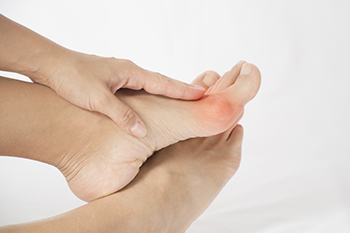
A bony bump that forms on the side of the big toe is considered to be a deformity. This condition is called a bunion and may cause the big toe to shift toward the other toes. A bunion generally occurs from wearing shoes that do not have adequate room for the toes to move freely, thus putting pressure on the joint in the big toe. Interestingly, the word bunion is derived from the Greek word for turnip. A bunion can be red and swollen and shaped like a turnip. Bunions gradually develop, and the growth may be slowed by wearing shoes with a larger toe area. There are also medical reasons linked to the development of bunions, including rheumatoid arthritis and gout, as well as genetic history. Recurring and Severe bunions may require surgery for permanent removal. It is strongly suggested that you confer with a podiatrist who can determine what the best course of treatment is for you.
If you are suffering from bunion pain, contact one of our podiatrists of Grobowski Foot & Ankle. our doctors can provide the care you need to keep you pain-free and on your feet.
What Is a Bunion?
Bunions are painful bony bumps that usually develop on the inside of the foot at the joint of the big toe. As the deformity increases over time, it may become painful to walk and wear shoes. Women are more likely to exacerbate existing bunions since they often wear tight, narrow shoes that shift their toes together. Bunion pain can be relieved by wearing wider shoes with enough room for the toes.
Causes
- Genetics – some people inherit feet that are more prone to bunion development
- Inflammatory Conditions - rheumatoid arthritis and polio may cause bunion development
Symptoms
- Redness and inflammation
- Pain and tenderness
- Callus or corns on the bump
- Restricted motion in the big toe
In order to diagnose your bunion, your podiatrist may ask about your medical history, symptoms, and general health. Your doctor might also order an x-ray to take a closer look at your feet. Nonsurgical treatment options include orthotics, padding, icing, changes in footwear, and medication. If nonsurgical treatments don’t alleviate your bunion pain, surgery may be necessary.
If you have any questions, please feel free to contact one of our offices located in Bellevue, Seattle, and Issaquah, WA, . We offer the newest diagnostic and treatment technologies for all your foot care needs.
